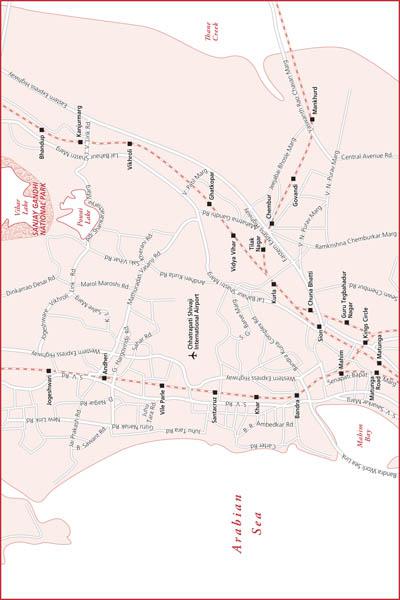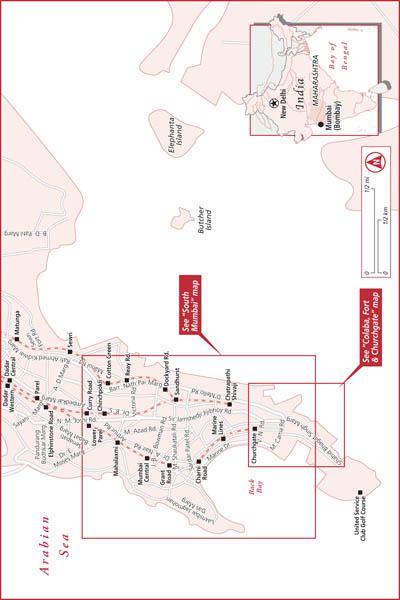India (Frommer's, 4th Edition) (41 page)

Days 11–13: Kovalam & Beyond
Drive to
Trivandrum
and continue beyond it to immerse yourself in the simple beach life at
Karikkathi Beach House
or the famous (and, sadly, recently expanded)
Surya Samudra.
Spread over 8 hectares (20 acres) amid terraced gardens, Surya has such a glorious setting that as soon as you arrive you will wonder why you didn’t come straight here in the first place. Accommodations are in the centuries-old carved wooden cottages transplanted from villages around Kerala. Much of your time here is best spent lazing by the infinity pool carved out of the rock bed or on one of the two beaches. Spend the rest of your time here enjoying Ayurvedic treatments and massages. At Karikkathi, on the other hand, there’s no pool, no other guests, and a dazzling beach pretty much all to yourself. If you can bear to tear yourself away, take an early morning excursion to sacred
Kanyakumari,
the southernmost tip of India, where three oceans meet and crowds worship the sunrise; or to
Padmanabhapuram Palace,
for several centuries the traditional home of Kerala’s Travancore royal family.
Day 14: Trivandrum & Home
Completely relaxed and rejuvenated, make your way back to Trivandrum, and from there fly to Mumbai or Bengaluru for your international flight back home. If you arrive in Mumbai, where you will have many hours before your flight, enjoy dinner at one of the marvelous restaurants in Mumbai’s suburbs or at one of the hotels near the airport where many Mumbaikers regularly go for upmarket entertainment and spoiling service.
Chapter 5: City of Dreamers: Mumbai & Maharashtra Side Trips
On track to becoming the world’s largest city within the next decade, Mumbai will do no less than bowl you over. It is a mind-boggling megalopolis—for some, a fantastic whirlwind of chaotic, exuberant energies; for others, a disorderly mess, frightening in the way of some biblical Gomorrah. There’s no doubt about it—Mumbai will not leave you unaffected.
Teetering on the edge of the Arabian Sea, its heaving population barely contained by palm-fringed beaches, India’s commercial capital, formerly known as Bombay, is a vibrant, confident metropolis that’s tangibly high in energy.
Originally home to Koli fisherfolk, the seven swampy islands that today comprise Mumbai originally commanded little significance. The largest of the islands was part of a dowry given by Portugal to England, which promptly took control of the six remaining islands and then leased the lot to the East India Company for a paltry £10. Massive land-reclamation projects followed, and by the 19th century all seven islands had been fused to form one narrow promontory and India’s principal port.
Today the city continues to draw fortune-seekers from across the subcontinent. Thousands of newcomers squeeze their way in every day, adding to the coffers of greedy slumlords and placing the city, which already has a human density four times greater than New York City’s, on target for a population of 22 million by 2015. As India’s economy booms, Mumbai’s real estate prices have soared through the roof as investors continue to scour every acre for viable new projects, rapidly transforming the city into an incredible futurescape of remarkable high-rises. And in the midst of it all sprawls Asia’s largest slum, a relatively flat and sodden terrain that is home to a million poor—yet extremely industrious—souls. In a bid to show the world how Mumbai’s vivacious spirit exists in even the most trying circumstances, there are now a few riveting tours that take you under the belly of the city, into the vast shantytown that shook the world with vivid scenes in
Slumdog Millionaire
and
Shantaram
. A city with a dual identity, Mumbai is as flamboyantly materialistic as it is downright choked by squalor and social drudgery. The citizens of Mumbai pay almost 40% of India’s taxes, yet half of its 18 million people are slum dwellers. While the moneyed groovers and label-conscious shakers retire in luxury behind the security gates of their million-dollar Malabar Hill apartments, emaciated survivors stumble home to cardboard shacks in congested shantytowns or onto tiny patches of open pavement. At every intersection these destitute hopefuls stand, framed against a backdrop of Bollywood vanity boards and massive billboards selling supersexy underwear and sleek mobile-phone technology. Feeding into this social schizophrenia are the one-dollar whores, half-naked fakirs, underworld gunmen, bearded
sadhus,
globe-trotting DJs, and, of course, movie moguls and wannabe starlets.
Many believe that is the city’s unputdownable prosperity that has made it a target for such tragic incidents as the 2008 attacks in which the main train terminus as well as two of the city’s finest hotels—the Taj Mahal Palace and The Oberoi—were besieged by terrorists. True to its spirit, however, following this and other violent assaults, Mumbaikers have always bounced back with spectacular vigor. The city is once again pumping with energy, and while there’s a noticeable security presence, spirits are definitely on the up. Even as the world recoils in economically uncertain times—and some of Mumbai’s myriad building projects did seem to pause for a while—there seems to be no stopping the pace of development. Touch down here and you’ll discover a metropolis that’s comfortably on the move.
It’s not just the economic disparities that are bewildering: Looking down from the Hanging Gardens on Malabar Hill, you see the assertively modern metropolis of Nariman Point—but just a little farther south, on Malabar Hill, is the Banganga Tank, one of the city’s holiest sites, where apartment blocks overlook pilgrims who come to cleanse their souls by bathing in its mossy waters. Twenty-first-century Mumbai is brassy and vital, yet it can also transport you to another epoch. It is, in this sense, a quintessentially Indian city, encapsulating the raw paradoxes of the entire subcontinent.
Your plane will almost certainly touch down in Mumbai—it’s the most common point of arrival for visitors, and well connected to the rest of the country (including the magnificent
Ajanta and Ellora Caves,
located in northern Maharashtra, and described later in this chapter). If you’re looking for peace and quiet in meditative surroundings, you should definitely consider heading to the nearby city of
Pune
where the
Osho International Meditation Resort
(also discussed in this chapter) is a major draw for global citizens on the search for New Age enlightenment packaged in its most upmarket avatar. If Mumbai is to be purely a transit hub, there are more than enough connections—by plane, train or road—for you to move on as fast as jet lag and arrival times dictate. But if you want to experience modern India at its vibrant best, and dine at what are arguably some of the finest restaurants in the country, tarry for at least 2 days. You may arrive appalled by the pitiful faces of the poor, shocked by the paradox of such wealth and poverty, and overcome by the heavy, heady stench and toxic pollution. But give India’s dream factory a little time, and you’ll discover it has a sexy, smoldering soul, and a head-spinning groove worth getting hip to.
 You Say Mumbai, I Say Bombay
You Say Mumbai, I Say Bombay
In 1995, Bombay, the name the British bestowed upon the city, was renamed in honor of the local incarnation of the Hindu goddess Parvati, “Mumba Devi.” The city’s name change (along with a host of others that harked back to its colonial past) was enforced by the ruling Shiv Sena, a Hindu fundamentalist party that eschews the presence of any other than the Marathi people, a glaring irony given that this is a city of immigrants—a cocktail influenced as much by the grand Gothic monuments left by the British as by the many cultures who’ve set up shop here. Although it’s difficult to understand how goodwill can prevail in a city led by politicians bred on xenophobia, Mumbai’s well-intentioned optimism and its social cosmopolitanism prevail, and many of Mumbai’s English-speaking inhabitants still refer to it as Bombay.
1 Arrival & Orientation
Greater Mumbai


WHEN TO GO
Mumbai’s humidity—even in the small hours of the morning—is felt instantly, and the sun shines year-round, except in the monsoon months. You always seem drenched in warm sweat, and the heat can be terribly cruel, making sightseeing far less agreeable than a tour of the city’s wonderful restaurants and drinking holes. Winter (Nov–Feb) is still hot, although not so entirely unpleasant; the sultry sea air sets the tone for an adventure in exotic dining and an intoxicating jaunt through lively, Victorian-era streets that are constantly crammed with people. The only real relief from the heat comes for brief periods in December and January, and midyear, when the annual monsoon drenches the city with heavy, nonstop tropical rains. Although the monsoon can be a difficult time to explore the city (and has in the past brought life-threatening floods), it can also be beautiful to watch the downpour from the safety of a well-located terrace or from under a sturdy umbrella.
ARRIVING
BY PLANE
Mumbai’s sprawling
Chhatrapati Shivaji International Airport
(
www.csia.in
) is looking a whole lot better than it did just a few years ago, and continues to undergo renovation; things may not seem world class just yet, but they’re definitely getting there (there’s even a Disney-themed children’s corner designed to stave off boredom during long waits between flights). The
International Terminal
(2A and 2C; 022/2681-3000
022/2681-3000
) is located in Sahar, 29km (18 miles) north of Colaba, the touristy enclave in the city’s far south. Flights typically arrive and depart between midnight and dawn, which can make finding your feet difficult; catch the evening flight on
Kingfisher Airlines
(
www.kingfisher.com
) from London, however, and you’ll land midmorning (after a spectacularly comfortable flight, by the way). A
Government of India Tourist Office
( 022/2682-9248
022/2682-9248
) at the airport should be open 24 hours but—as is the case in most of India’s tourist offices—it’s certainly not the best place to obtain advice; you’ll find the contents of this book far more useful.
